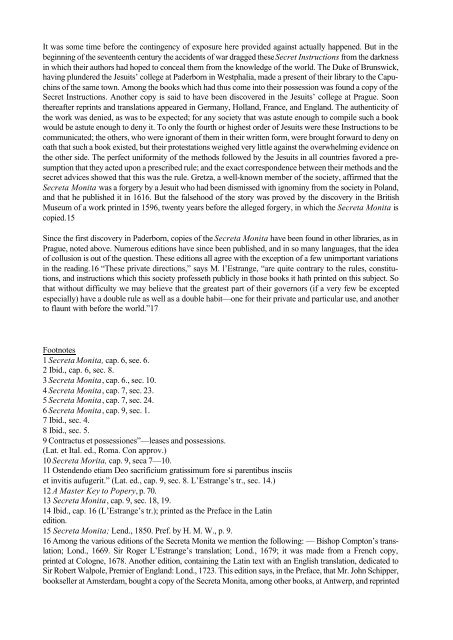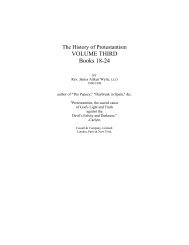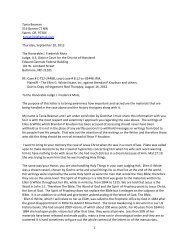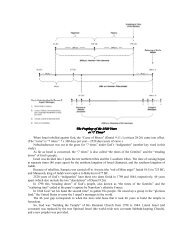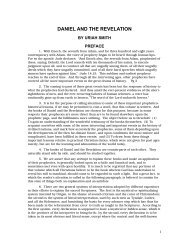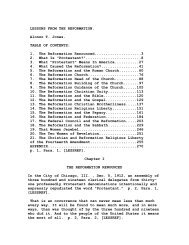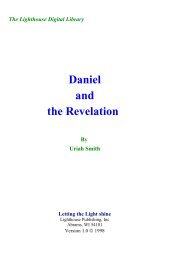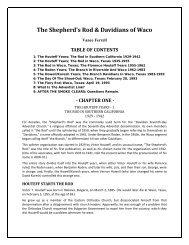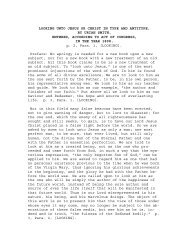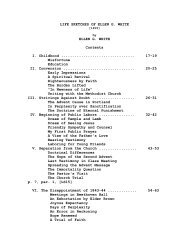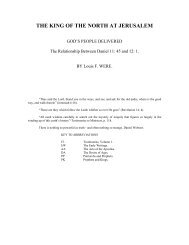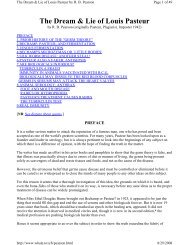History of Jesuits
History of Jesuits
History of Jesuits
You also want an ePaper? Increase the reach of your titles
YUMPU automatically turns print PDFs into web optimized ePapers that Google loves.
It was some time before the contingency <strong>of</strong> exposure here provided against actually happened. But in the<br />
beginning <strong>of</strong> the seventeenth century the accidents <strong>of</strong> war dragged these Secret Instructions from the darkness<br />
in which their authors had hoped to conceal them from the knowledge <strong>of</strong> the world. The Duke <strong>of</strong> Brunswick,<br />
having plundered the <strong>Jesuits</strong>’ college at Paderborn in Westphalia, made a present <strong>of</strong> their library to the Capuchins<br />
<strong>of</strong> the same town. Among the books which had thus come into their possession was found a copy <strong>of</strong> the<br />
Secret Instructions. Another copy is said to have been discovered in the <strong>Jesuits</strong>’ college at Prague. Soon<br />
thereafter reprints and translations appeared in Germany, Holland, France, and England. The authenticity <strong>of</strong><br />
the work was denied, as was to be expected; for any society that was astute enough to compile such a book<br />
would be astute enough to deny it. To only the fourth or highest order <strong>of</strong> <strong>Jesuits</strong> were these Instructions to be<br />
communicated; the others, who were ignorant <strong>of</strong> them in their written form, were brought forward to deny on<br />
oath that such a book existed, but their protestations weighed very little against the overwhelming evidence on<br />
the other side. The perfect uniformity <strong>of</strong> the methods followed by the <strong>Jesuits</strong> in all countries favored a presumption<br />
that they acted upon a prescribed rule; and the exact correspondence between their methods and the<br />
secret advices showed that this was the rule. Gretza, a well-known member <strong>of</strong> the society, affirmed that the<br />
Secreta Monita was a forgery by a Jesuit who had been dismissed with ignominy from the society in Poland,<br />
and that he published it in 1616. But the falsehood <strong>of</strong> the story was proved by the discovery in the British<br />
Museum <strong>of</strong> a work printed in 1596, twenty years before the alleged forgery, in which the Secreta Monita is<br />
copied.15<br />
Since the first discovery in Paderborn, copies <strong>of</strong> the Secreta Monita have been found in other libraries, as in<br />
Prague, noted above. Numerous editions have since been published, and in so many languages, that the idea<br />
<strong>of</strong> collusion is out <strong>of</strong> the question. These editions all agree with the exception <strong>of</strong> a few unimportant variations<br />
in the reading.16 “These private directions,” says M. l’Estrange, “are quite contrary to the rules, constitutions,<br />
and instructions which this society pr<strong>of</strong>esseth publicly in those books it hath printed on this subject. So<br />
that without difficulty we may believe that the greatest part <strong>of</strong> their governors (if a very few be excepted<br />
especially) have a double rule as well as a double habit—one for their private and particular use, and another<br />
to flaunt with before the world.”17<br />
Footnotes<br />
1 Secreta Monita, cap. 6, see. 6.<br />
2 Ibid., cap. 6, sec. 8.<br />
3 Secreta Monita, cap. 6., sec. 10.<br />
4 Secreta Monita, cap. 7, sec. 23.<br />
5 Secreta Monita, cap. 7, sec. 24.<br />
6 Secreta Monita, cap. 9, sec. 1.<br />
7 Ibid., sec. 4.<br />
8 Ibid., sec. 5.<br />
9 Contractus et possessiones”—leases and possessions.<br />
(Lat. et Ital. ed., Roma. Con approv.)<br />
10 Secreta Morita, cap. 9, seca 7—10.<br />
11 Ostendendo etiam Deo sacrificium gratissimum fore si parentibus insciis<br />
et invitis aufugerit.” (Lat. ed., cap. 9, sec. 8. L’Estrange’s tr., sec. 14.)<br />
12 A Master Key to Popery, p. 70.<br />
13 Secreta Monita, cap. 9, sec. 18, 19.<br />
14 Ibid., cap. 16 (L’Estrange’s tr.); printed as the Preface in the Latin<br />
edition.<br />
15 Secreta Monita; Lend., 1850. Pref. by H. M. W., p. 9.<br />
16 Among the various editions <strong>of</strong> the Secreta Monita we mention the following: — Bishop Compton’s translation;<br />
Lond., 1669. Sir Roger L’Estrange’s translation; Lond., 1679; it was made from a French copy,<br />
printed at Cologne, 1678. Another edition, containing the Latin text with an English translation, dedicated to<br />
Sir Robert Walpole, Premier <strong>of</strong> England: Lond., 1723. This edition says, in the Preface, that Mr. John Schipper,<br />
bookseller at Amsterdam, bought a copy <strong>of</strong> the Secreta Monita, among other books, at Antwerp, and reprinted


